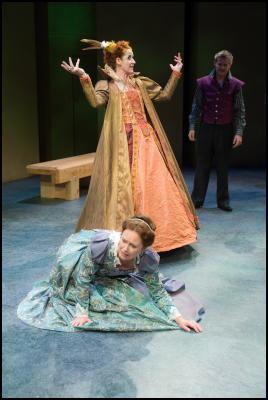Arts Festival Review: Mary Stuart
Arts Festival Review: Mary Stuart
Review by Richard Thomson

Click to enlarge
Carmel McGlone as Queen Elizabeth (russet dress) and Tina Regtien as Mary Stuart (aqua/lavender dress) with Aaron Alexander as Lord Leicester. Photography - Stephen A'Court
Mary Stuart
by Friedrich Schiller
a new version by
David Harrower
27 February – 3 April
Circa
Theatre
Review by Richard Thomson
Friedrich Schiller's reputation as one of the great European playwrights is, on the basis of this adaptation by David Harrower, well deserved. Here, the death of Mary Stuart is imagined as a struggle between two sixteenth-century queens, Mary and Elizabeth, in a world unused to female rule.
Politics and religion combine with jealousy, ambition and betrayal in a complex, densely plotted and demandingly worded play that will resonate for any fan of The Sopranos or observer of modern-day world politics: "If the cause is just, what do appearances matter?" is the rhetorical challenge made by one of Elizabeth's advisors.
Mary Stuart is perhaps better known as Mary Queen of Scots, a lamely romantic title that probably intentionally demeans the threat she once posed to the Protestant English state. Mary's father was Elizabeth's cousin, making her next in line to the English throne. Worse, in the opinion of many Catholics, Mary was the rightful heir because they considered Elizabeth to be illegitimate.
In Ross Jolly's production the politics in the play is well-crafted and paced, as Elizabeth's advisors compete to influence her decisions and the subtleties of each character's ethics and politics is revealed.
Tina Regtien's Mary is vivacious and warm – perhaps almost too friendly sometimes, for a born-to-rule queen locked up for 20 years in a castle – but she also demonstrates pride, a quick temper and agility in verbal combat.
Elizabeth, as portrayed by Carmel McGlone, I found a more intriguing character. On this interpretation she is wracked by doubt and indecision, her questioning self-confidence sounding almost wheedling at times. The intention here, I imagine, is to emphasise that it was Mary's death that made her as a queen, yet I'm not sure it entirely succeeds. The script could equally well support a more cooly calculating personality, more adept at reading and manipulating those around her.
That might also have helped address a certain lack of passion in the play: if power is an aphrodisiac, then more self-assured displays of power might help to unbutton the eroticism the publicity promises but which never really delivered.
I hope, too, that as the season progresses the actors will grow more comfortable with the text. This is a play that shows little tolerance for anyone who has not mastered its often difficult and crowded lines, and there were times, especially in the first half, when the scale of this task threatened to overwhelm the cast.
But despite the speed wobbles, this is a production that shows decisive assurance about its destination: the two-tracked final act unravels all the pride, rapacity, and dread in a starkly stunning piece of theatre.
Arts Festival Website: Mary Stuart
Other Productions: Binoy Kampmark: Mary Stuart in Copenhagen
Scoop Full Coverage: Arts Festival 2010


 Gordon Campbell: On Free Speech And Anti-Semitism
Gordon Campbell: On Free Speech And Anti-Semitism Ian Powell: The Disgrace Of The Hospice Care Funding Scandal
Ian Powell: The Disgrace Of The Hospice Care Funding Scandal Binoy Kampmark: Catching Israel Out - Gaza And The Madleen “Selfie” Protest
Binoy Kampmark: Catching Israel Out - Gaza And The Madleen “Selfie” Protest Ramzy Baroud: Gaza's 'Humanitarian' Façade - A Deceptive Ploy Unravels
Ramzy Baroud: Gaza's 'Humanitarian' Façade - A Deceptive Ploy Unravels Keith Rankin: Remembering New Zealand's Missing Tragedy
Keith Rankin: Remembering New Zealand's Missing Tragedy Gordon Campbell: On Why The Regulatory Standards Bill Should Be Dumped
Gordon Campbell: On Why The Regulatory Standards Bill Should Be Dumped